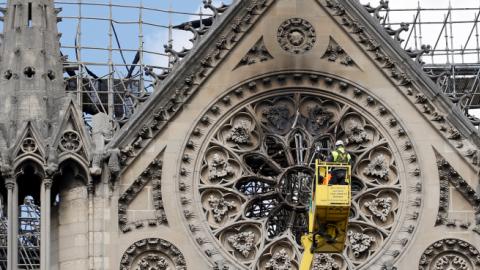On Easter Sunday in France, a fire originating in a Notre Dame confessional received little attention. That Notre Dame was not the great cathedral in Paris, but an ordinary church in Tarascon, near Marseille. In February, Notre Dame of Dijon was vandalized, with Hosts scattered about At Notre Dame Church in Nimes, a cross was recently drawn on the wall using excrement and consecrated Communion Hosts. Notre Dame of France Catholic bookstore was vandalized last September. None of the attacks on these other Notre Dames drew much notice, either.
The flames that ravaged Paris’ Notre Dame riveted the world because it is a legendary, architectural masterpiece at the center of France’s capital and much of its political history. For those who track religious-freedom threats, the fire itself may be less of a surprise than that it apparently was started by accident.
Hundreds of other French churches are being quietly burned or damaged — in deliberate attacks.
Ellen Fantini, who directs the watchdog Observatory on Intolerance and Discrimination Against Christians in Europe, told me in an email that church attacks in France have been relentless for the past four years. Thanks to her efforts and the diligent documentation of French journalist Daniel Hamiche, I can point to a few examples here. This destruction, at the hands of a variety of actors, barely receives a glance from the French state, prosecutors, media or public. Rarely are the attackers identified or apprehended.
We also see this happening to churches in Northern Cyprus, Egypt, northern Nigeria and other places where certain members of society are hostile to a small and weak Christian community and the government itself is indifferent.
To be sure, unlike these other places and in Sri Lanka over Easter, the French churches are not filled with worshippers when attacked — or, for that matter, hardly ever filled these days. Nevertheless, it is a shock to see the same governmental failure to protect houses of worship in a country with a strong rule of law.
The overwhelming majority of French churches attacked are Catholic, but some have been Protestant and Eastern Orthodox. As Fantini commented, “They [the churches] don’t seem high on the agenda when it comes to the political will to provide protection.” As a result, French Christian churches are being gradually destroyed, one by one. We cannot expect this to stop until there is adequate state protection and an end to legal impunity. To do that, France needs to identify the circumstances and motives of those behind the attacks.
In March, St. Sulpice, Paris’ second-largest church after Notre Dame, was the site of a fire that was officially declared arson Its pastor, Msgr. Jean-Loup Lacroix, reported that homeless people started the fire but did not do so out of religious hatred. In many cases the unprotected churches are preyed on by thieves, which indicates criminal intent, if not hatred. The Cathedral of Saint-Louis in Fort de France, for example, was robbed five times last December. Ten churches in two weeks, in two dioceses, were looted in February, though, in a rare example of police action, two men were arrested.
But many times, the culprits are a variety of extremists enraged by the identities and teachings that the churches symbolize — Christianity, French nationalism and Western civilization at large. Even the Cathedral of Notre Dame’s burning is perceived by some as a “liberation,” as a Harvard professor informed Rolling Stone The magazine explained that the cathedral served for some French as a “deep-seated symbol of resentment, a monument to a deeply flawed institution and an idealized Christian European France that arguably never existed in the first place.”
Ironically, they are targeting churches, when, as a 2018 Pew survey found, only 18% of the French attend church even monthly, and the churches’ influence over French politics and culture is diminishing to the vanishing point. While arrests are few, a mix of ideologies and motives is readily apparent from the graffiti the vandals often leave. They are shown to be radical secularists, anarchists, leftists, feminists, sexual libertarians, Islamists, radical Muslims and a Satanist group, which religion scholar Massimo Introvigne says is minuscule in France. Due to the breadth of hostile forces, Fantini calls France the “worst country in Europe” for Christians.
In January, Grenoble’s Saint-Jacques Church burned to the ground shortly after the slogan blessed abortion was graffitied on it during a right-to-life rally there. An anarcho-libertarian group claimed responsibility on the blog site “Le seule église qui ...” . The site’s name references an infamous early-20th-century anarchist slogan: “The only church that illuminates is a burning church.” Officials had quickly pronounced it an electrical fire from a short-circuit and dismissed the anarchists as “opportunists.” The investigation continues.
Last July, after Saint-Pierre du Matroi Church in Orléans was attacked by arson, “Allahu akbar” was found graffitied on its surviving walls. The Cathedral of Saint-Jean of Besançon was vandalized with the slogan “our lives, our bodies belong to us” and the anarchist “A.”
The Basilica of Saint-Jean-Baptiste de Chaumont was spray-painted with anarchist symbols and the word “Satan” with a heart symbol. Last year, the façade and double doors of the 1,000-year-old Notre Dame Cathedral in Strasbourg were graffitied with the anarchist motto “Neither God nor Master.” Graffiti on the Saint-Roch-du-Férétra Chapel in Toulouse stated: “Church on fire,” “Dirty priest” and “Satan punishes homophobes.”
Islamist terrorists and other radicalized Muslims have led France’s most deadly attacks against Christians: the Islamists who slit the throat of Father Jacques Hamel in Normandy’s Saint-Etienne du Rouvray while he celebrated morning Mass in 2016 and those who conducted the ISIS-inspired terrorist attack on Strasbourg’s Christmas Market in December, which killed five and wounded a dozen. These perpetrators were shot by police. Arrests occurred in the cases of radicalized Muslims who showed up at the Cathedral Saint-Vincent de Chalon-sur-Saône and the 13th-century Cathedral of Notre Dame in Reims, threatening to blow them up, as well as in the case of a Syrian woman, wearing a Venetian face mask, who entered Sainte-Marie-Madeleine and took an ax to the holy water font, a side altar bas relief and a statue, where she placed a Quran — all in front of terrified congregants.
In September 2016, a Moroccan Muslim man was arrested reportedly for being a serial church arsonist, setting fires to three churches in Millau. Outside Paris, police arrested an Algerian Muslim man suspected of planning an attack on “one or two churches,” as he was reportedly advised to do by a contact in Syria.
Numerous unidentified vandals, acting with clear anti-Catholic animus, have aimed at what Catholics hold most sacred, the consecrated Hosts. Statues of Jesus and Mary have been shattered, defaced or beheaded and crosses broken or turned upside down. Christian cemeteries have reported hundreds of grave stones toppled and graffitied, including with blue Nazi swastikas, like those recently found desecrating France’s Jewish cemeteries.
Church leaders themselves seem reluctant to discuss the attacks.
“We do not want to develop a discourse of persecution. We do not wish to complain,” Archbishop Georges Pontier, who heads the French bishops’ conference, said when asked about the church attacks in March. He redirected press attention instead to French anti-Semitism, which is also a serious threat, though he did tell the Register such incidents were taken seriously I was reminded of what veteran Church scholar George Weigel observed a decade ago, “Too many European bishops have internalized a sense of their own irrelevance and the Church’s.”
The outpouring of emotion, prayers and funds after the Notre Dame blaze was heartening. And the heroic demonstration of faith of Father Jean-Marc Fournier, the Paris fire brigade chaplain who rescued from the burning cathedral the Blessed Sacrament, chalices, monstrances and sacred relics, was especially inspirational.
No graffiti or claim of responsibility has surfaced to suggest that the Notre Dame fire was anything but an accident. And while the example of Notre Dame may not rekindle appreciation for France’s Christian patrimony, it should stir a demand for the government to protect it.















